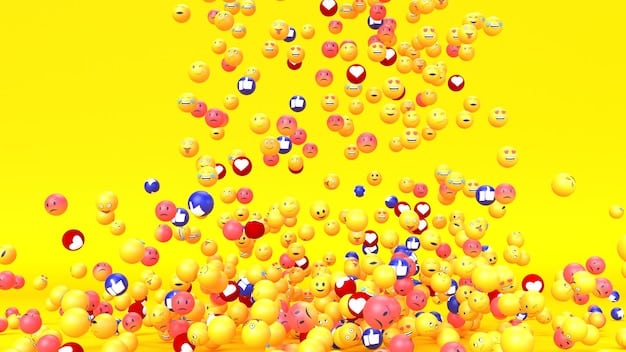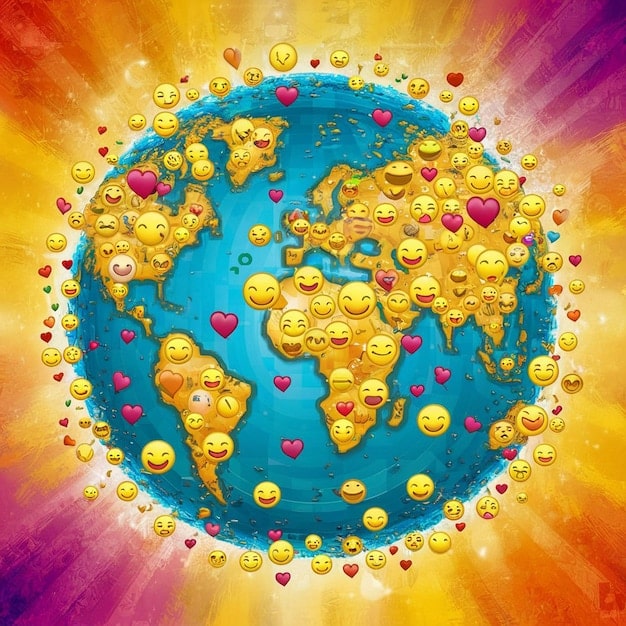The Evolution of Emojis: How Visual Language Shaped the Internet in the US

The Evolution of Emojis: Decoding the Visual Language of the Internet in the US explores how these small digital icons have transformed online communication, reflecting American culture and influencing global digital expression.
The digital world is constantly evolving, and with it, the ways we communicate. One of the most significant shifts in online communication has been the rise of emojis. **The Evolution of Emojis: Decoding the Visual Language of the Internet in the US** reveals how these tiny digital icons have profoundly reshaped how Americans express themselves online.
The Genesis of Emojis: From Japan to the US
Emojis, those ubiquitous symbols that pepper our digital conversations, weren’t always a global phenomenon. Their journey began in Japan, but their assimilation into American culture has been transformative. Understanding this origin provides insight into how emojis evolved to become a key component of online communication in the US.
Early Days in Japan: The Birth of Emojis
In the late 1990s, Shigetaka Kurita, a member of NTT DoCoMo’s i-mode team, created the first emojis. These 176 pixelated images were designed to enhance electronic messaging and serve as a visual shorthand. They were an instant hit in Japan, catering to the nuanced and context-rich communication style prevalent in the culture.
Crossing the Pacific: Emojis Arrive in the US
The introduction of emojis to the US was a gradual process. Initially, they were used primarily within Japanese online communities before slowly gaining traction among early adopters of smartphones and digital communication technologies. The Unicode Consortium’s standardization efforts played a crucial role in ensuring that emojis could be universally recognized across different platforms and devices.

Key Moments in Emoji Adoption in the US:
- Early 2000s: Emojis began to appear in niche online communities and forums.
- 2010: Apple integrated emojis into iOS, significantly increasing their visibility and usage among iPhone users.
- 2015: Oxford Dictionaries declared the “Face with Tears of Joy” emoji as its Word of the Year, highlighting the cultural impact of emojis.
The integration of emojis into mainstream American culture marked a significant shift. Emojis were no longer just cute symbols; they became essential tools for expressing emotions, adding context, and enhancing communication in a digital world.
The Rise of Emoji Culture in American Digital Communication
As emojis became more integrated into digital platforms, their role in American online communication grew exponentially. They’ve transformed how people express emotions, convey tone, and even replace words in digital conversations. Understanding this evolution provides insight into the cultural significance of emojis in the US.
Emojis as Emotional Shorthand
Emojis provide a way to convey emotions and nuances in text-based communication, which can often be misinterpreted. A simple smiley face can soften a message, while a heart emoji can express affection or support. This emotional shorthand has become invaluable in online interactions, especially in a culture where quick and efficient communication is prized.
Emoji Trends and Viral Moments
Certain emojis have become wildly popular, often driven by viral trends and social media challenges. The “Face with Tears of Joy” emoji, for example, was ubiquitous for years, while newer emojis like the “melting face” have gained traction for expressing irony or sarcasm. These trends reflect how emojis are constantly evolving to meet the changing needs of online communicators.

- Memes and Emojis: Emojis are frequently used in memes to add humor and relatability.
- Hashtags and Emojis: Many social media campaigns use specific emojis to promote engagement and brand recognition.
- Emoji Challenges: Viral challenges often involve using emojis to tell stories or express feelings in creative ways.
The rise of emoji culture in American digital communication highlights their adaptability and importance in conveying emotion in a way that is instant and universally understandable.
Emojis and the Reflection of American Culture
Emojis are not just tools for communication; they also reflect American cultural values, societal shifts, and identity. The way emojis are used and interpreted in the US provides a lens through which we can understand broader cultural trends. From reflecting diversity to showcasing cultural stereotypes, emojis offer a fascinating glimpse into American society.
Representation and Diversity in Emojis
The push for greater representation in emojis has been a significant movement. Initially, emojis primarily featured light-skinned faces, leading to calls for more diverse options. The Unicode Consortium has since added options for different skin tones, hair types, and family structures, reflecting a growing awareness of the need for inclusivity.
Cultural Stereotypes and Emoji Use
While emojis can promote inclusivity, they can also perpetuate cultural stereotypes. Certain emojis may be associated with particular ethnic groups or cultural practices, which can sometimes lead to misinterpretations or offense. Being mindful of these potential pitfalls is essential for responsible emoji use.
Emojis and American Identity
Emojis also play a role in expressing American identity. From using the US flag emoji to celebrate national holidays to incorporating emojis that represent American foods or symbols, emojis provide a visual way to showcase national pride and cultural identity.
Emojis are a product of the culture that adopts it. Their transformation and use reflects the cultural values, societal shifts, and identity of a region and its community.
Emojis in Business and Marketing: Connecting with Consumers
Businesses have recognized the power of emojis in connecting with consumers and enhancing their marketing efforts. Emojis can humanize brands, make communications more engaging, and even serve as a cost-effective way to convey complex messages. From social media campaigns to customer service interactions, emojis are becoming an integral part of the business landscape.
Emoji Marketing Campaigns
Many brands have launched successful emoji marketing campaigns, using emojis to promote products, engage with customers, and create memorable experiences. These campaigns often involve creating custom emojis or using popular emojis in creative and unexpected ways.
Emojis in Customer Service
Emojis are also used in customer service interactions to add a personal touch and convey empathy. A simple smiley face can help defuse tense situations and create a more positive customer experience. However, it’s essential to use emojis judiciously and avoid appearing unprofessional.
Benefits of Using Emojis in Business Communication:
- Increased Engagement: Emojis can capture attention and encourage interaction.
- Improved Brand Perception: Emojis can make brands seem more relatable and approachable.
- Enhanced Communication: Emojis can clarify messages and prevent misunderstandings.
Emojis help brands to connect with the consumers and make the entire business ecosystem to appear more personalized and relatable which is well appreciated by the customers.
The Future of Emojis: What’s Next?
As technology continues to evolve, so too will emojis. The future of emojis holds exciting possibilities, from more personalized and interactive emojis to new ways of using them in virtual and augmented reality environments. Staying informed about these developments is crucial for understanding how emojis will continue to shape digital communication.
Personalized Emojis and Avatars
One trend to watch is the rise of personalized emojis and avatars. Services like Bitmoji and Memoji allow users to create custom emojis that resemble themselves, adding a personal touch to online communication. This trend is likely to continue, with more sophisticated tools for creating personalized digital representations.
Emojis in Virtual and Augmented Reality
Emojis are also poised to play a significant role in virtual and augmented reality environments. Imagine using emojis to express emotions in a virtual meeting or overlaying emojis onto real-world objects using augmented reality. These applications could transform how we interact with technology and each other.
The Evolution of Emoji Design
Emoji design will likely continue to evolve to meet the changing needs of users. This could involve creating more inclusive and representative emojis, refining existing designs for greater clarity, and introducing new categories of emojis to reflect emerging trends and cultural phenomena.
The world of technology is ever evolving. With new technologies making its way to the foray of our lives, the applications of emojis are set to become more personalized and interactive.
Criticisms and Controversies Surrounding Emojis
Despite their widespread popularity, emojis have faced criticisms and controversies. Concerns about cultural appropriation, misinterpretations, and the potential for misuse have sparked ongoing debates. Addressing these issues is crucial for promoting responsible and inclusive emoji use.
Cultural Appropriation Concerns
Some emojis have been criticized for appropriating cultural symbols or practices without proper understanding or respect. This can lead to misunderstandings and offense, especially when emojis are used out of context or in a way that trivializes cultural traditions.
Misinterpretations and Ambiguity
Emojis can sometimes be misinterpreted, especially when used across different cultural contexts. What might be considered a humorous emoji in one culture could be seen as offensive in another. This ambiguity can lead to misunderstandings and communication breakdowns.
- Emoji Meanings Vary: The same emoji can have different meanings depending on the context and the individual.
- Cultural Context Matters: Emojis should be used with awareness of cultural sensitivities.
The Dark Side of Emojis
Though predominantly used in positive contexts, emojis can be misused for cyberbullying and in harassment over online forums. This is an important consideration when dealing with responsible usage of emojis.
Conclusion
The evolution of emojis is a fascinating journey that reflects the changing landscape of digital communication in the US. From their humble beginnings in Japan to their current status as a ubiquitous form of expression, emojis have transformed how Americans communicate, connect, and express themselves online. As technology continues to evolve, emojis will undoubtedly continue to play a significant role in shaping the future of digital communication.
| Key Aspect | Brief Description |
|---|---|
| 😊 Origin Story | Emojis originated in Japan in the late 1990s and gradually made their way to the US. |
| 😂 Cultural Impact | Emojis have become essential for expressing emotions and conveying tone in digital communication. |
| 👍 Business Use | Companies use emojis in marketing and customer service to enhance engagement and brand perception. |
| 🤔 Future Trends | The future of emojis includes personalized avatars and integration into virtual and augmented reality. |
Frequently Asked Questions
Emojis began appearing in niche online communities in the early 2000s. However, their widespread adoption in the US started around 2010 when Apple integrated them into iOS.
Emojis provide a quick and easy way to express emotions, convey tone, and add context to text-based messages, which can often be misinterpreted without visual cues.
Businesses use emojis to create engaging and relatable content, promote products, and enhance customer interactions. They can also use them to convey complex messages in a concise way.
Some criticisms of emoji use include concerns about cultural appropriation, the potential for misinterpretations, and the possibility of misuse for cyberbullying or harassment.
The future of emojis includes personalized avatars, integration into virtual and augmented reality, and the development of more inclusive and representative emoji designs to reflect diverse cultures and identities.
Conclusion
In conclusion, emojis have become an integral part of American digital communication, reflecting cultural values, enhancing online interactions, and transforming how businesses connect with consumers. As technology advances, emojis will continue to evolve, offering new ways to express ourselves and engage with the digital world.





